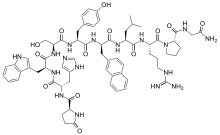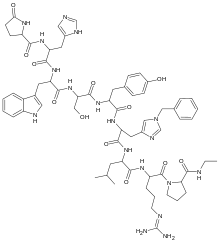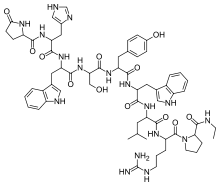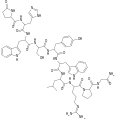Gonadotropin-releasing hormone agonist
| Gonadotropin-releasing hormone agonist | |
|---|---|
| Drug class | |
|
Leuprorelin (leuprolide), one of the most widely used GnRH agonists. | |
| Class identifiers | |
| Synonyms | GnRH receptor agonists; GnRH blockers; GnRH inhibitors; Antigonadotropins |
| Use | Infertility; Prostate cancer; Precocious puberty; Breast cancer; Endometriosis; Uterine fibroids; Transgender people |
| Biological target | GnRH receptor |
| Chemical class | Peptides |
| In Wikidata | |
A gonadotropin-releasing hormone agonist (GnRH agonist, GnRH–A) is a type of drug that acts as an agonist of the GnRH receptor, the biological target of gonadotropin-releasing hormone (GnRH). These drugs can be both peptides and small-molecules. They are modeled after the hypothalamic neurohormone GnRH, which interacts with the GnRH receptor to elicit its biologic response, the release of the pituitary hormones follicle-stimulating hormone (FSH) and luteinizing hormone (LH). However, after the initial "flare" response, continued stimulation with GnRH agonists desensitizes the pituitary gland (by causing GnRH receptor downregulation) to GnRH. Pituitary desensitization reduces the secretion of LH and FSH and thus induces a state of hypogonadotropic hypogonadal anovulation, sometimes referred to as “pseudomenopause” or “medical oophorectomy.”[1][2]
GnRH agonists are pregnancy category X drugs.
Medical uses
GnRH agonists are useful in:
- Suppression of spontaneous ovulation as part of controlled ovarian hyperstimulation, which is an essential component in in vitro fertilisation (IVF). Typically, after GnRH agonists have induced a state of hypoestrogenism, exogenous FSH is given to stimulate ovarian follicle, followed by human chorionic gonadotropins (hCG) to trigger oocyte release. GnRH agonists routinely used for this purpose are: buserelin, leuprorelin, nafarelin, and triptorelin.[3]
- Final maturation induction after having performed controlled ovarian hyperstimulation. Usage of GnRH agonist for this purpose necessitates using a GnRH antagonist instead of a GnRH agonist for suppression of spontaneous ovulation, because using GnRH agonist for that purpose as well inactivates the axis for which it is intended to work for final maturation induction.
- Treatment of cancers that are hormonally sensitive and where a hypogonadal state decreases the chances of a recurrence. Thus they are commonly employed in the medical management of prostate cancer and have been used in patients with breast cancer.
- Treatment of delaying puberty in individuals with precocious puberty.
- Delaying puberty pending treatment decisions in children with gender dysphoria
- Management of female disorders that are dependent on estrogen productions. Women with menorrhagia, endometriosis, adenomyosis, or uterine fibroids may receive GnRH agonists to suppress ovarian activity and induce a hypoestrogenic state.
- Suppressing hormone levels in transsexual people, especially trans women.
- Severe cases of congenital adrenal hyperplasia
- Temporary Suppression of Fertility in Female Dogs
- Induction of Ovulation in Mares
Women of reproductive age who undergo cytotoxic chemotherapy have been pretreated with GnRH agonists to reduce the risk of oocyte loss during such therapy and preserve ovarian function. Further studies are necessary to prove that this approach is useful.
Side effects
Side effects of the GnRH agonists are signs and symptoms of hypoestrogenism, including hot flashes, headaches, and osteoporosis. In patients under long-term therapy, small amounts of estrogens could be given back (“add-back regimen”) to combat such side effects and to prevent bone wastage. Generally, long-term patients, both male and female, tend to undergo annual DEXA scans to appraise bone density.
There is also a report that GnRH agonists used in the treatment of advanced prostate cancer may increase the risk of heart problems by 30%.[4]
Flare effect and downregulation
Agonists do not quickly dissociate from the GnRH receptor. As a result, initially there is an increase in FSH and LH secretion (so-called "flare effect"). Levels of LH may increase by up to 10-fold.[5] However, after about 10 to 20 days,[5] a profound hypogonadal effect (i.e. decrease in FSH and LH) is achieved through receptor downregulation by internalization of receptors. Generally this induced and reversible hypogonadism is the therapeutic goal.
Agonists with double and single substitutions
GnRH agonists are synthetically modeled after the natural GnRH decapeptide with specific modifications, typically in position 6 (amino acid substitution), 9 (alkylation) and 10 (deletion). These substitutions inhibit rapid degradation. Agonists with two substitutions include: leuprolide (Lupron, Eligard), buserelin (Suprefact, Suprecor), histrelin (Supprelin LA, Vantas), goserelin (Zoladex), and deslorelin (Suprelorin, Ovuplant). The agents nafarelin (Synarel) and triptorelin are agonists with single substitutions at position 6.
Administration
These medications can be administered intranasally, by injection, or by implant. Injectables have been formulated for daily, monthly, and quarterly use; and implants can last from 1 to 12 months.
See also
References
- ↑ Magon N (October 2011). "Gonadotropin releasing hormone agonists: Expanding vistas". Indian Journal of Endocrinology and Metabolism. 15 (4): 261–7. PMC 3193774
 . PMID 22028996. doi:10.4103/2230-8210.85575.
. PMID 22028996. doi:10.4103/2230-8210.85575. - ↑ Roth C, Hegemann F, Hildebrandt J, Balzer I, Witt A, Wuttke W, Jarry H (January 2004). "Pituitary and gonadal effects of GnRH (gonadotropin releasing hormone) analogues in two peripubertal female rat models". Pediatric Research. 55 (1): 126–33. PMID 14605254. doi:10.1203/01.PDR.0000100463.84334.3F.
- ↑ van Loenen AC, Huirne JA, Schats R, Hompes PG, Lambalk CB (November 2002). "GnRH agonists, antagonists, and assisted conception". Seminars in Reproductive Medicine. 20 (4): 349–64. PMID 12536358. doi:10.1055/s-2002-36713.
- ↑ "Researchers Suggest Hormone Therapy for Prostate Cancer Can Cause Serious Heart Problems and Death". Genetic Engineering & Biotechnology News. 22 September 2009.
- 1 2 Wein AJ, Kavoussi LR, Novick AC, Partin AW, Peters CA (25 August 2011). Campbell-Walsh Urology: Expert Consult Premium Edition: Enhanced Online Features and Print, 4-Volume Set. Elsevier Health Sciences. pp. 2939–. ISBN 978-1-4160-6911-9.
External links
- Buserelin website
- Use of agonists in endometriosis
- Lupron, by manufacturer
- Lupron victims hub, website against use of this drug.
- 10th International Symposium on GnRH
- SupprelinLA, by Endo Pharmaceuticals, Inc.
- Information of use of Zoladex in prostate cancer






